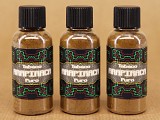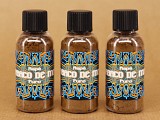Bottle, 10 Ml, 6 Gr from Brazil (SKU 5054)
The most sought-after Tabaco is known as Sabiá. It stands out as one of the most potent and revered varieties of Nicotiana Rustica. Its rich history, traditional production methods, and versatile use in Rapé and other Tabaco products make it a valuable component of Brazilian Tabaco culture. The craftsmanship involved in its cultivation and preparation reflects the deep knowledge and heritage of the communities that produce it, ensuring that Sabia Corda Tabaco remains a vital part of both traditional and modern practices. The fine powder is ideal for personal Rapé blends. When mixed with ashes in a simple 50-50 ratio, it creates a potent yet balanced Rapé, similar to traditional blends used by indigenous tribes across South America. Detailed information can be found below.
Packed in 10 ml clear plastic bottles containing 6 gr.
| change currency | |||||||||
| SKU | Part | Volume | Weight | Unit | Price | Qty
|
|||
|---|---|---|---|---|---|---|---|---|---|
| 5054 | bottle | 10 ml | 6 gr | 1 pc | $ 7.56 | ||||
| 5055 | bottle | 25 ml | 14 gr | 1 pc | $ 15.11 | ||||
| 5090 | pot | 60 ml | 30 gr | 1 pc | $ 30.23 | ||||
| 5091 | pot | 100 ml | 50 gr | 1 pc | $ 45.34 | ||||
Sabia is considered the highest quality and most potent Tabaco.
Sabia Corda Tabaco: A Deep Dive into Its Tradition, Craftsmanship, and Potency
Sabia Corda Tabaco is a distinctive variety of Nicotiana Rustica, known for its dark, nearly black appearance and its potent effects. This particular type of Tabaco is highly prized among Rapé makers for its strength and neutral flavour, making it a preferred choice for creating powerful and balanced Rapé blends. The craft of producing Sabia Corda is deeply rooted in traditional Brazilian Tabaco farming practices, where the careful cultivation, drying, and fermentation processes contribute to its unique characteristics.
Historical Background and Cultural Significance
Sabia Corda Tabaco is a testament to the rich heritage of Brazilian Tabaco farming, with its cultivation and production methods passed down through generations. The seeds of this Tabaco have been handed down from father to son, maintaining the purity and potency of the strain. The Sabia Corda Tabaco belongs to the widely known species of Nicotiana Rustica, a variety that is historically significant for its high nicotine content and robust flavor profile. In indigenous and rural communities, Tabaco is more than just a crop; it is a symbol of cultural continuity, community knowledge, and traditional craftsmanship.
Cultivation and Production Process
The production of Sabia Corda Tabaco is a meticulous process that involves several stages, each contributing to the final product's quality. The Tabaco plants are organically grown in the jungles of Brazil, benefiting from the region's rich soil and favorable climate. Chemical fertilizers and pesticides are unnecessary, as Tabaco itself is a natural insecticide and soil enhancer.
After the Tabaco leaves are harvested, they are sorted based on quality and placed on drying racks in the shade. This careful drying process preserves the leaves' natural oils and flavors, which are crucial for the next stage: fermentation. Fermentation is key to developing the Tabaco deep, rich flavors. During this process, the leaves darken significantly, taking on the nearly black hue that Sabia Corda is known for. The Tabaco is then twisted into ropes, a traditional method that not only preserves the Tabaco but also allows for the slow release of its rich, earthy flavors as it ages.
The rolling of the Tabaco leaves into ropes is a skilled craft, requiring experience and knowledge passed down through generations. The ropes are allowed to ripen further, undergoing a slow fermentation process that enhances the flavor and creates the characteristic dark brown to black appearance of Sabia Corda Tabaco. The result is a tightly wrapped, dense rope of Tabaco, sticky to the touch due to its high moisture and oil content.
Characteristics and Uses
Sabia Corda Tabaco is distinct in its appearance and texture. The ropes have a smaller diameter than those of other similar Tabaco's, such as Mapacho Masos, measuring approximately 3-4 cm. The leaves are darker, almost black, and the Tabaco is notably juicy and aromatic. When fresh, the ropes are sticky and dense, indicating their high quality and potency.
This variety of Tabaco is favored by Rapé makers due to its strength. When used with less ash, Sabia Corda Tabaco creates a Rapé that is intensely powerful and not recommended for the faint-hearted. Its neutral flavor allows it to blend well with various herbs and ashes, making it versatile for creating different Rapé blends. Some of the popular Rapé varieties that incorporate Sabia Corda include the Yawanawa Daime, Kuntanawa Alfavaca da Mata, and several Nukini blends.
The Role of Sabia Corda in Rapé Production
Rapé often relies on the strength and potency of the Tabaco used in its production. Sabia Corda Tabaco is particularly sought after in this context because of its high nicotine content and grounding effects. These qualities make it ideal for spiritual practices where focus, clarity, and connection to the earth are essential. The neutral flavor of Sabia Corda also makes it a versatile base for blending with other ingredients, allowing Rapé makers to create a wide range of effects and flavors.
Conclusion
Sabia Corda Tabaco stands out as one of the most potent and revered varieties of Nicotiana Rustica. Its rich history, traditional production methods, and versatile use in Rapé and other Tabaco products make it a valuable component of Brazilian Tabaco culture. The craftsmanship involved in its cultivation and preparation reflects the deep knowledge and heritage of the communities that produce it, ensuring that Sabia Corda Tabaco remains a vital part of both traditional and modern practices.
Whether used in sacred rituals, for smoking, or in the production of Rapé, Sabia Corda Tabaco offers a unique and powerful experience, deeply rooted in the traditions of Brazilian Tabaco craftsmanship. Its strong, earthy flavor, coupled with the cultural significance of its production, makes it a standout among the many varieties of Tabaco grown in Brazil.
Powdered Sabia Tabaco
Sabia, in its raw form, is notably moist and sticky, with an almost damp appearance. Transforming this dense mass into a fine powder requires considerable effort. Its oily texture makes it particularly challenging to pass through a fine sieve, often needing several rounds of grinding and drying to achieve the desired consistency. The resulting fine powder is ideal for personal Rapé blends. When mixed with ashes in a simple 50-50 ratio, it creates a potent yet balanced Rapé, similar to traditional blends used by indigenous tribes across South America. A higher ash content results in a sharper blend, while a higher concentration of Sabia yields a more grounding and powerful Rapé. The possibilities are endless when experimenting with different ash and Tabaco combinations, though it's recommended to start with simpler blends. Understanding each component individually before creating more complex mixtures is key. Sabia is perfect for those interested in exploring custom blends or adding a grounding dimension to a grey Rapé.
Sabia is used in Rapé varieties like the Yawanawa Daime, the Kuntanawa Alfavaca da Mata, some of the Nukini and other all-time favourites.
We take great care to transform the Sabia into the finest quality powder. We meticulously dehydrate, grind and sieve the oily Tabaco to remove rough bits and particles, resulting in an exceptionally smooth and effective powder at 150-micron fineness. We use laboratory-grade sieves and dehydrating equipment to achieve this quality. This is our standard because it provides the best Rapé experience.
Image: Sabia Corda on a roll weighing 10 kilo.
Scientific name: Nicotiana Rustica
Part used: Leaves
Form: String, on 10 kilo rolls
Region of origin: Tocantins, Minas Gerais state
Lot number: 38943
Method of processing: The Tabaco leaves are fermented and then rolled into rope form Tabaco mass, and then cured.
Appearance: String, rolled up in rolls of Tabaco mass
Colour: Black
Odour: Tabaco
Taste: Tabaco
Uses: Alcoholic tinctures, natural agriculture, apiculture
Customer feedback:
"..This one is totally different from the other Tabaco’s. It’s effect is very strong, even stronger than the Arapiraca. The smell is totally different and needs a bit of getting used to for me. This Tabaco is too strong for snorting, in my experience. My nose instantly got into an allergic reaction and blocked up totally. So the deepest respect for this creation of Tabaco, I understand why local shamans look for it to make their medicines..."
See here how to make powder from raw Tabaco.
See here how to blend your own Rapé.
Other names: Sabia, Sabia Corda
All South American shamans have an intimate relationship with Tabaco, and consider it a very sacred, wholesome plant that is deeply entrenched in their culture and rites. Tabaco consumed in high amounts has strong psychedelic and hallucinogenic effects, as it contains two alkaloids, harman and norharman, which are closely related to harmine and harmaline (Janiger et al. 1973). These two beta-carbolines inhibit monoamine oxidase (Herraiz et al. 2005), leading to antidepressive and uplifting effects (Farzin 2006).
In addition to Ayahuasca rituals that are combined with Tabaco snuffs, there are even shamans that specialized in Tabaco healing, called tobaqueros (Jauregui et al. 2011). When used in shamanic rituals, Tabaco is assumed to protect, cleans and re-align energies, thereby bringing profound clarity and healing (Jauregui et al. 2011). Furthermore, South American shamans, commonly use Tabaco smoke to blow it over the person to be healed with the intention to bring their energies into equilibrium and clean out all negativity and anxiety (i.e. ‘sopladas’ – the healing energy of blowing) (Jauregui et al. 2011). Thus, Tabaco in the shamanistic culture has a potent function of cleansing, bringing clarity and focus, and for allowing strong visualisations.
This item is not allowed in the following countries:
Finland
This natural product is offered for its ethnographic and historical value and is delivered with no expressed or implied fitness for a specific purpose. It is simply a raw botanical specimen, or a scientific sample. The information provided is purely meant for historical, scientific and educational purposes and should never be interpreted as a recommendation for a specific use. The use and application of our product is at the customer's decision, responsibility and risk.
Read our Terms & Conditions for more details.





